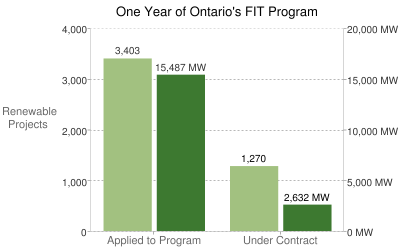This is part of a series on distributed renewable energy posted to Grist. It originally appeared on Energy Self-Reliant States, a resource of the Institute for Local Self-Reliance’s New Rules Project.
 The Canadian province of Ontario has launched a clean energy strategy to maximize economic development while reducing pollution. “Maximizing Jobs From Clean Energy: Ontario’s ‘Buy Local’ Policy,” a new report from the Institute for Local Self-Reliance (ISLR), details how Ontario’s bold clean energy program — in just over a year — has resulted in the promise of 43,000 clean energy jobs and over 15,000 megawatts in applications by clean energy projects.
The Canadian province of Ontario has launched a clean energy strategy to maximize economic development while reducing pollution. “Maximizing Jobs From Clean Energy: Ontario’s ‘Buy Local’ Policy,” a new report from the Institute for Local Self-Reliance (ISLR), details how Ontario’s bold clean energy program — in just over a year — has resulted in the promise of 43,000 clean energy jobs and over 15,000 megawatts in applications by clean energy projects.
The centerpiece of Ontario’s program is a long term contract for renewable energy developers with a guaranteed return on investment. To qualify for a contract, developers must source 60 percent of their project’s value from inside the province. The rule effectively means that no solar or wind project built in Ontario can obtain a contract without having some components manufactured locally.
This domestic content or “buy local” rule has spurred a fast-growing renewable energy industry in the province, with over 20 new manufacturing plants proposed and scheduled to open in the next two years. And the rule is a simple, comprehensive economic development strategy for renewable energy that is in stark contrast with the complexity of clean energy programs and incentives utilized in the United States that are split between utilities, states, and the federal government.
ILSR’s report estimates a cost per job created of $143,000 for the Ontario program, a cost comparable to or below non-energy related job subsidy programs in the United States and significantly less than some recent clean energy job creation efforts.
Costs in the U.S. would be lower, often significantly, because most U.S. states have higher electricity prices and stronger renewable energy resources. Colorado, for example, has a solar resource that would allow it to provide solar developers a similar return on investment at a 33 percent lower price for power and its higher retail electricity price would further reduce the marginal costs of the program and the resulting jobs.
The full report is available on ILSR’s New Rules Project website.



